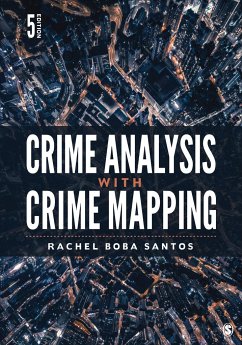Rachel Boba Santos (USA Radford University)
Crime Analysis with Crime Mapping
Rachel Boba Santos (USA Radford University)
Crime Analysis with Crime Mapping
- Broschiertes Buch
- Merkliste
- Auf die Merkliste
- Bewerten Bewerten
- Teilen
- Produkt teilen
- Produkterinnerung
- Produkterinnerung
Crime Analysis With Crime Mapping introduces crime analysis, both the practice and profession, and supports the understanding of it all through discussing concepts, theories, practices, data, analysis techniques, and the relationship with policing.
Andere Kunden interessierten sich auch für
![Gangs in America′s Communities Gangs in America′s Communities]() James C. C. Howell (USA National Youth Gang Center)Gangs in America′s Communities113,99 €
James C. C. Howell (USA National Youth Gang Center)Gangs in America′s Communities113,99 €![Organized Crime Organized Crime]() Klaus von LampeOrganized Crime109,99 €
Klaus von LampeOrganized Crime109,99 €![Data Visualization & Presentation With Microsoft Office Data Visualization & Presentation With Microsoft Office]() Valerie M. SueData Visualization & Presentation With Microsoft Office109,99 €
Valerie M. SueData Visualization & Presentation With Microsoft Office109,99 €![Working with Political Science Research Methods Working with Political Science Research Methods]() Jason D. MycoffWorking with Political Science Research Methods80,99 €
Jason D. MycoffWorking with Political Science Research Methods80,99 €![Qualitative Comparative Analysis in Mixed Methods Research and Evaluation Qualitative Comparative Analysis in Mixed Methods Research and Evaluation]() Leila KahwatiQualitative Comparative Analysis in Mixed Methods Research and Evaluation81,99 €
Leila KahwatiQualitative Comparative Analysis in Mixed Methods Research and Evaluation81,99 €![Applied Thematic Analysis Applied Thematic Analysis]() Greg GuestApplied Thematic Analysis116,99 €
Greg GuestApplied Thematic Analysis116,99 €![Exploratory Factor Analysis Exploratory Factor Analysis]() Holmes FinchExploratory Factor Analysis52,99 €
Holmes FinchExploratory Factor Analysis52,99 €-
-
-
Crime Analysis With Crime Mapping introduces crime analysis, both the practice and profession, and supports the understanding of it all through discussing concepts, theories, practices, data, analysis techniques, and the relationship with policing.
Produktdetails
- Produktdetails
- Verlag: SAGE Publications Inc
- 5 Revised edition
- Seitenzahl: 504
- Erscheinungstermin: 21. April 2022
- Englisch
- Abmessung: 250mm x 173mm x 31mm
- Gewicht: 800g
- ISBN-13: 9781071831403
- ISBN-10: 1071831402
- Artikelnr.: 62893215
- Herstellerkennzeichnung
- Libri GmbH
- Europaallee 1
- 36244 Bad Hersfeld
- gpsr@libri.de
- Verlag: SAGE Publications Inc
- 5 Revised edition
- Seitenzahl: 504
- Erscheinungstermin: 21. April 2022
- Englisch
- Abmessung: 250mm x 173mm x 31mm
- Gewicht: 800g
- ISBN-13: 9781071831403
- ISBN-10: 1071831402
- Artikelnr.: 62893215
- Herstellerkennzeichnung
- Libri GmbH
- Europaallee 1
- 36244 Bad Hersfeld
- gpsr@libri.de
Rachel Boba Santos is a professor at Radford University in the Department of Criminal Justice. She works with police departments and crime analysts. She conducts experimental and applied research on place-based and offender-based police crime reduction strategies, stratified policing, crime analysis, community engagement, and police use of force. Dr. Santos¿ interests include conducting practice-based research which is implementing and evaluating evidence-based practices in the "real world" of criminal justice. In particular, she seeks to improve crime prevention and crime reduction efforts by police in areas such as crime analysis, problem solving, accountability, as well as leadership and organizational change. She and Dr. Roberto Santos co-created Stratified Policing which is an organizational model for systemizing proactive crime reduction strategies in police departments. Other areas of research include police/researcher partnerships, police/community collaboration, hot spot and problem-oriented policing, predictive policing, environmental criminology, crime and place, police/crime data and technology, experimental research methodology, and program evaluation.
PART I: Foundations of Crime Analysis
Chapter 1: Crime Analysis and the Profession
Chapter 2: Theoretical Foundations of Crime Analysis
Chapter 3: Evidence-Based Policing and Problem Solving
PART II: Crime Analysis Process, Data, and Products
Chapter 4: Crime Analysis Process and Types
Chapter 5: Crime Analysis Data and Technology
Chapter 6: Geographic Data and Crime Mapping
Chapter 7: Crime Analysis Products and Communication
PART III: Tactical Crime Analysis
Chapter 8: Calls for Service Data and Repeat Incident Analysis
Chapter 9: Crime Data and Pattern Identification
Chapter 10: Persons and Property Crime Patterns
Chapter 11: Crime Pattern Bulletins, Response, and Evaluation
PART IV: Strategic Crime Analysis
Chapter 12: Statistics and Trends
Chapter 13: Long-Term Problem Analysis, Part I
Chapter 14: Long-Term Problem Analysis, Part II
Chapter 15: Evaluation of Response and Crime Reduction Goals
Chapter 1: Crime Analysis and the Profession
Chapter 2: Theoretical Foundations of Crime Analysis
Chapter 3: Evidence-Based Policing and Problem Solving
PART II: Crime Analysis Process, Data, and Products
Chapter 4: Crime Analysis Process and Types
Chapter 5: Crime Analysis Data and Technology
Chapter 6: Geographic Data and Crime Mapping
Chapter 7: Crime Analysis Products and Communication
PART III: Tactical Crime Analysis
Chapter 8: Calls for Service Data and Repeat Incident Analysis
Chapter 9: Crime Data and Pattern Identification
Chapter 10: Persons and Property Crime Patterns
Chapter 11: Crime Pattern Bulletins, Response, and Evaluation
PART IV: Strategic Crime Analysis
Chapter 12: Statistics and Trends
Chapter 13: Long-Term Problem Analysis, Part I
Chapter 14: Long-Term Problem Analysis, Part II
Chapter 15: Evaluation of Response and Crime Reduction Goals
PART I: Foundations of Crime Analysis
Chapter 1: Crime Analysis and the Profession
Chapter 2: Theoretical Foundations of Crime Analysis
Chapter 3: Evidence-Based Policing and Problem Solving
PART II: Crime Analysis Process, Data, and Products
Chapter 4: Crime Analysis Process and Types
Chapter 5: Crime Analysis Data and Technology
Chapter 6: Geographic Data and Crime Mapping
Chapter 7: Crime Analysis Products and Communication
PART III: Tactical Crime Analysis
Chapter 8: Calls for Service Data and Repeat Incident Analysis
Chapter 9: Crime Data and Pattern Identification
Chapter 10: Persons and Property Crime Patterns
Chapter 11: Crime Pattern Bulletins, Response, and Evaluation
PART IV: Strategic Crime Analysis
Chapter 12: Statistics and Trends
Chapter 13: Long-Term Problem Analysis, Part I
Chapter 14: Long-Term Problem Analysis, Part II
Chapter 15: Evaluation of Response and Crime Reduction Goals
Chapter 1: Crime Analysis and the Profession
Chapter 2: Theoretical Foundations of Crime Analysis
Chapter 3: Evidence-Based Policing and Problem Solving
PART II: Crime Analysis Process, Data, and Products
Chapter 4: Crime Analysis Process and Types
Chapter 5: Crime Analysis Data and Technology
Chapter 6: Geographic Data and Crime Mapping
Chapter 7: Crime Analysis Products and Communication
PART III: Tactical Crime Analysis
Chapter 8: Calls for Service Data and Repeat Incident Analysis
Chapter 9: Crime Data and Pattern Identification
Chapter 10: Persons and Property Crime Patterns
Chapter 11: Crime Pattern Bulletins, Response, and Evaluation
PART IV: Strategic Crime Analysis
Chapter 12: Statistics and Trends
Chapter 13: Long-Term Problem Analysis, Part I
Chapter 14: Long-Term Problem Analysis, Part II
Chapter 15: Evaluation of Response and Crime Reduction Goals








